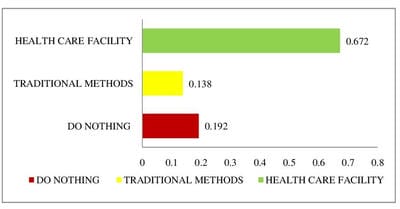A cross sectional study of knowledge, attitude and practices regarding zoonotic diseases among agricultural workers
Kulkarni V.1*, Reddi L.2
DOI: https://doi.org/10.17511/ijphr.2018.i2.04
1* Ved. P. Kulkarni, Professor, Department of Community Medicine, Maharajah’s Institute of Medical Sciences, Vizianagaram, Andhra Pradesh, India.
2 L.Venkata Reddi, Post Graduate, Department of Community Medicine, Maharajah’s Institute of Medical Sciences, Vizianagaram, Andhra Pradesh, India.
Introduction: Zoonoses are the naturally transmitted infections between vertebrate animals and humans. Material & Methods: A cross-sectional study was conducted to assess the knowledge, attitude and practice regarding zoonotic diseases among agricultural workers using a structured questionnaire to obtain information on knowledge, awareness about zoonotic diseases, source of infection, modes of transmission, hygienic practices and treatment methods followed by the study subjects. A total of 139 agricultural workers were selected from Saripalli village, Vizianagaram district, Andhra Pradesh, India. Selection of study subjects was done on basis of presence of livestock. Results: The mean age of the study population is 43.63 + 2.84 years.Proportion of those who knew that infections transmit from livestock to humans were 96.4%. 75.37% had knowledge about transmission of zoonotic diseases and in this 58.2% believe that these diseases are transmitted through direct contact. Regarding transmission of zoonotic diseases through consumption of milk and meat was only 27.33% and 18.23% which was found very low. 77% of respondents showed positive attitude towards use of protective and safety measures but in reality, only 32% of them showed positive practice. Only 58.9% were practicing regular hand washing and only 44.6% clean the animal sheds with ordinary water. 67.20% of them pay a visit to health care facility while 13.8% use traditional methods and remaining 19 % do nothing when any of the animal in their livestock gets sick. Conclusion: Major proportion of agricultural workers have adequate knowledge about zoonotic diseases and its transmission but lack proper practice methods in prevention and control of these diseases.
Keywords: Zoonotic disease, Knowledge, Practice, Agricultural workers
| Corresponding Author | How to Cite this Article | To Browse |
|---|---|---|
| , Professor, Department of Community Medicine, Maharajah’s Institute of Medical Sciences, Vizianagaram, Andhra Pradesh, India. Email: |
Kulkarni VP, Reddi LV. A cross sectional study of knowledge, attitude and practices regarding zoonotic diseases among agricultural workers. Public Health Rev Int J Public Health Res. 2018;5(2):71-76. Available From https://publichealth.medresearch.in/index.php/ijphr/article/view/85 |


 ©
© 